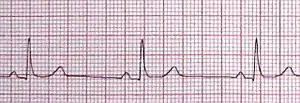心跳过缓
心跳过慢(Bradycardia)也称心动过缓、心跳过缓、心动徐缓、徐脉。是指心脏跳动速度低于正常水平,达到每分钟60次以下的现象。心跳过慢可能是由迷走神经亢奋、窦房结病变、窦房结的冲动波遭到阻挡等原因引起,常见于老年人、心脏病患者[3]
| 心跳过慢 | |
|---|---|
 | |
| 低于每分钟60次的窦性心跳过慢 | |
| 类型 | 心律不整, finding of heart rate[*] |
| 分类和外部资源 | |
| 醫學專科 | 心臟內科 |
| ICD-10 | R00.1 |
| ICD-9-CM | 427.81, 659.7, 785.9, 779.81 |
| Patient UK | 心跳过缓 |
| MeSH | D001919 |
| Bradycardia | |
|---|---|
| 同义词 | bradyarrhythmia, brachycardia |
| 读音 |
|
| 类型 | 心律不整, finding of heart rate[*] |
| 分类和外部资源 | |
| 醫學專科 | Cardiology |
| Patient UK | 心跳过缓 |
Bradycardia is a condition wherein an individual has a slow heart rate, typically defined as a heart rate of under 60 beats per minute (BPM) in adults.[1] Bradycardia typically does not cause symptoms until the rate drops below 50 BPM. When symptomatic, it may cause fatigue, weakness, dizziness, sweating, and at very low rates, fainting.[2]
During sleep, a slow heartbeat with rates around 40–50 BPM is common, and is considered normal. Highly trained athletes may also have athletic heart syndrome, a very slow resting heart rate that occurs as a sport adaptation and helps prevent tachycardia during training.
The term relative bradycardia is used in explaining a heart rate that, although not actually below 60 BPM, is still considered too slow for the individual's current medical condition.
参考文献
- . July 1, 2011 [19 March 2015]. (原始内容存档于2015-06-07).
- Sinus Bradycardia 页面存档备份,存于 – eMedicine
- 心跳过缓 的存檔,存档日期2011-04-26.
